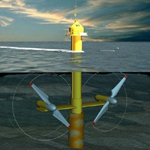


| Methodology |
Parametric Model Power Profiles Error Estimation
This section gives an overview of the method employed in the generation of the power profiles for the sites as well as assumptions used and the possible errors. The turbine parametric model used has also been included.
Parametric Model
The 1 MW design described in the Commercial Prospects of Tidal Stream document prepared by Binnie Black and Veatch in association with IT Power was adopted for this study. The concept is a twin rotor (2 x 500 kW) axial flow turbine mounted on a monopile founded in the seabed as shown below.
Key features:
- Variable-pitch mechanism allowing rotor blades to be adjusted through at least 1800so they can operate during both flood and ebb flows.
- The twin rotors are contra-rotating to minimise resultant forces on the support structure.
Power Profiles
The sequence of steps involved in the generation of the power profiles is as below:
- The speed variation with time was assumed to be sinusoidal completing a cycle every 12 hr 25 min. The maximum (reference) speed was taken as the mean of the mean neap and mean spring tides for both flood and ebb flow. The speeds were generated at one minute intervals. The chart tidal speeds were then compared to the sinusoidal speeds to estimate the level of accuracy.
- Armed with the sinusoidal speed variation and a choice of turbine parameters the available power for each speed was calculated. The actual power was then found by multiplying the available power by the power coefficient taking into account the rated speed of the turbine. This was then converted to electrical power output by multiplying by the gearbox transmission efficiency as well as the generator efficiency.
- The next step was the generation of power profiles (power output against time) for the various locations for a 12 hr 25mins cycle.
back to top
Error Estimation
The two main assumptions underlying the analysis are:
- Sinusoidal variation of tidal speeds
- 12 hr 25 min cycle repeating itself over time
back to top
